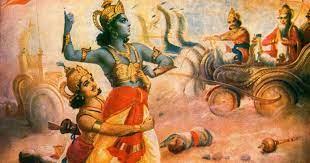Sanatan Dharma, also known as Hinduism, encompasses a rich tapestry of spiritual practices and philosophies. One of the central concepts within Hinduism is the concept of yoga, which offers different paths to attain self-realization and union with the divine. These paths, known as the yogas, provide individuals with various approaches to spiritual growth and enlightenment. Each path has its unique characteristics and methods, catering to the diverse needs and inclinations of individuals on their spiritual journey.

Karma Yoga (Path of Selfless Action):
Karma Yoga is the path of selfless action. It emphasizes performing one's duties without attachment to the results. The practitioner understands that their actions are an offering to the divine and serves humanity with love and compassion. Key characteristics of Karma Yoga include:
a) Selflessness: Practitioners focus on selfless service, performing actions for the benefit of others without expecting any personal gain or recognition.
b) Detachment: They cultivate a sense of detachment from the outcomes of their actions, recognizing that the results are beyond their control.
c) Renunciation of Fruits of Action: Karma Yogis offer the fruits of their actions to the divine, surrendering the sense of doership and ego.
Bhakti Yoga (Path of Devotion):
Bhakti Yoga is the path of devotion and love for the divine. It entails developing a deep, personal relationship with the chosen deity or form of the divine. Key characteristics of Bhakti Yoga include:
a) Devotion: Practitioners cultivate a loving and devotional relationship with the divine through rituals, prayer, chanting, and meditation.
b) Surrender: They surrender their ego and desires to the divine, recognizing the divine as the ultimate source of love, protection, and guidance.
c) Emotional Connection: Bhakti Yogis experience a deep emotional connection and longing for union with the divine, often expressed through ecstatic devotion and singing devotional hymns.
Jnana Yoga (Path of Knowledge and Wisdom):
Jnana Yoga is the path of knowledge and wisdom. It involves intellectual inquiry, self-inquiry, and discernment to realize the true nature of the self and the universe. Key characteristics of Jnana Yoga include:
a) Self-Inquiry: Practitioners engage in self-reflection and contemplation to discern the distinction between the eternal self (Atman) and the temporary physical body and mind.
b) Study of Scriptures: They study sacred texts and philosophical treatises to gain knowledge and insights into the nature of reality and the self.
c) Discrimination: Jnana Yogis cultivate discernment to differentiate between the eternal and the ephemeral, the real and the unreal, to attain liberation from ignorance.
Raja Yoga (Path of Meditation and Control of Mind):
Raja Yoga, also known as Ashtanga Yoga, is the path of meditation and control of the mind. It involves various techniques and practices to calm the mind and attain higher states of consciousness. Key characteristics of Raja Yoga include:
a) Meditation: Practitioners engage in systematic meditation practices, such as concentration (Dharana), meditation (Dhyana), and absorption (Samadhi), to attain union with the divine.
b) Control of Mind: They cultivate discipline and mastery over the mind and senses through practices like breath control (Pranayama) and ethical observances (Yamas and Niyamas).
c) Eight-Limbed Path: Raja Yoga follows the eightfold path outlined by Patanjali, including moral restraints, observances, physical postures, breath control, sense withdrawal, concentration, meditation, and absorption.